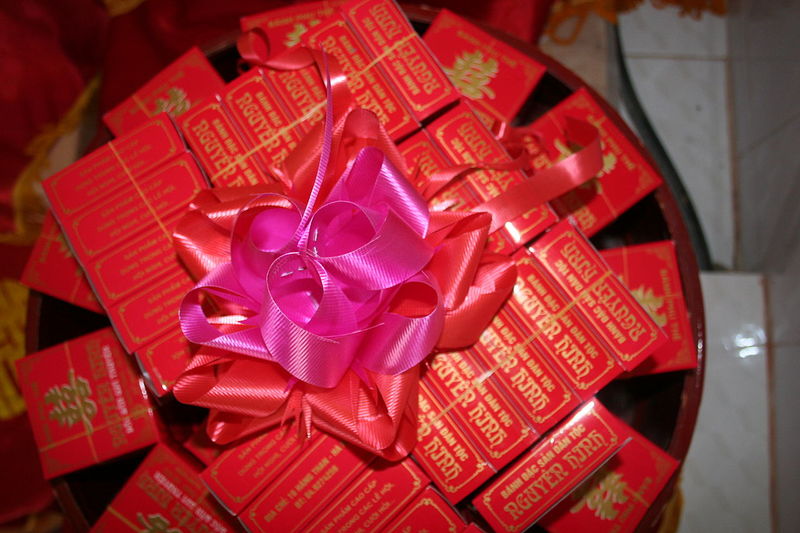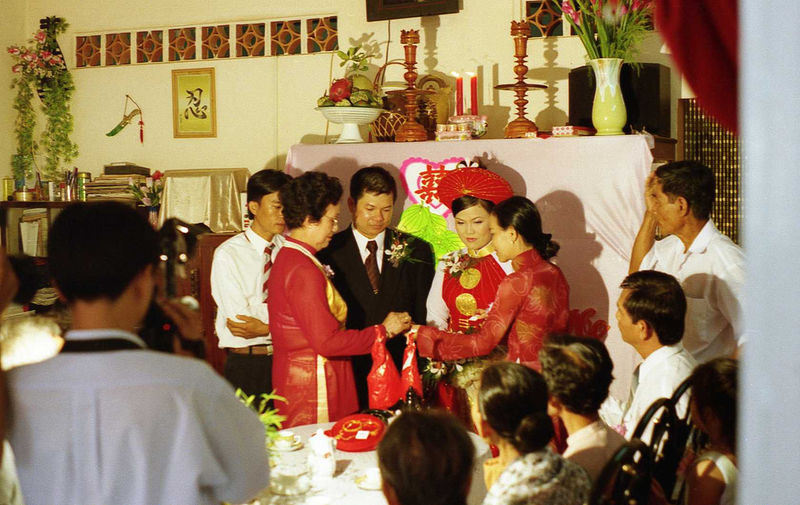Vietnamese Wedding
Vietnamese weddings start with an engagement ceremony ("le an hoi") where the groom's family presents gifts to the bride's family, guided by auspicious dates chosen with the help of a monk or fortuneteller. The wedding day features a procession with more gifts, ancestral prayers, and mutual blessings, followed by a large reception where the newlyweds visit each table to receive well-wishes and monetary gifts. After the reception, the bride and groom move to their new home, accompanied by both families.
Vietnamese Wedding
In cities the engagement or "le an hoi" is organized only a day before the wedding. In villages there is usually a month between these events. The Vietnamese do not find all dates for the important personal events favourable. That is why the couple and their families use the advice of a Buddhist monk or a local fortuneteller.
Both families choose representatives who are highly respectable family members. They organize the whole procedure. A groom's family arrives to the bride's home and brings many presents like for example areca nuts, betel leaves, "bánh phu thê" ("husband and wife cake"), fruits, sweets, tea etc.
These presents are covered with a red paper or cloth. They are carried on 5, 7 or 9 trays by a group of 5, 7 or 9 young single people. The same number of people who will except the presents are also chosen. Odd numbers are considerd lucky.
On the night before the wedding the bride's mother brushes the hair of her daughter with several combs. No comb has an equal meaning. The third one is the most important. When combing the hair with this comb the mother will pray for the happiness of her daughter and her new family.

"Le cuoi" or the wedding ceremony starts with the visit of the groom's family to the bride's home. They bring presents similar to those already mentioned as part of the engagement. The presents are packed in a red paper. The same as in some other Asian countries, like for example in China, red is considered lucky colour. So, this colour dominates at every Vietnamese wedding.
The presents are brought on trays by the group of happily married people. They are dressed in the traditional Vietnamese clothes. Women are wearing in the "áo dài" which consists of a silk tunic and pants. Men are wearing a traditional tunic called "áo gấm".
The richest couple among groom's cousins first enters the bride's home. They bring a tray with some wine. After the bride's parents drink some of the offered wine the groom's family enters the house. They are welcomed with fireworks.
The groom's parents then ask if it is possible that their son can get married with the bride. The whole event is managed by one of the bride's cousins. He asks the bride's parents to bring their daughter.
The bride's is dressed in a red "áo dài". She is accompanied by her bridesmaids.
Ancestors play an important role in the life of many Asian people. The Vietnamese couple first pray in front of the altar dedicated to the ancestors. Then the bride and groom thank their parents for the role they have been having in their lives.

The mutual bowing of the bride and groom is what is happening next. The master of the ceremony and the couple's parents talk to the couple about the importance of marriage in the life. The couple is then blessed by both parents.
The rings are exchanged. The newlyweds get some golden jewelery from their parents. After that everybody goes to the groom's house or some restaurant where the wedding reception is going to be held. It is common that the event includes several hundreds of guests. It is interesting to mention that some guests can sing to the couple.
It is a tradition that the newlyweds go from table to table. Their parents can join them too. The guest wish them all the best and usually give them some money. The money and wedding cards are placed in an envelope.
After the wedding reception bride and groom go to their new home. The groom's family members join them. Soon after the bride's parents arrive too to see more closely where their daugher is going to spend the rest of her life.
References
Wedding planning tips: Vietnamese Wedding
http://www.aawpa.com/weddingtips/vietnamese-wedding/
Ao dai
http://en.wikipedia.org/wiki/Ao_dai
Áo gấm
http://en.wikipedia.org/wiki/%C3%81o_g%E1%BA%A5m
Contemporary Vietnamese Traditional Weddings
http://www.haivenu-vietnam.com/vietnam-culture-wedding-today.htm
Vietnamese engagement ceremony
http://www.vietnam-culture.com/vietnamese-engagement-ceremony.aspx
Image(s)
Vietnamese country wedding (photo by Mike Fernwood, Flickr)
http://en.wikipedia.org/wiki/File:VNese_country_wedding.jpg
"Bánh phu thê" ("Husband and wife cake") - photo by Khương Việt Hà
http://commons.wikimedia.org/wiki/File:Banh_xu_xe_%28Vietnam%29.JPG
Creative Commons - File:Vietnam, Temple in Chau Doc 2.jpg